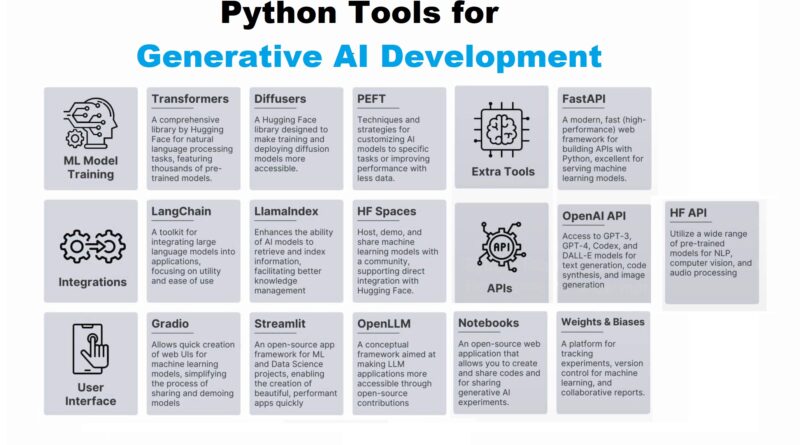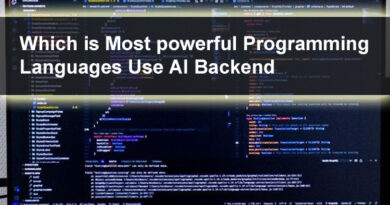Python Tools for Generative AI Development
Python Tools for Generative AI Development: Streamlining the Process with Ease
Artificial Intelligence which literally means acting or thinking like a human being has become inevitable in the society with its capability to perform tasks Python Tools. Another important area that is worth considering for future advancement in the field of AI is generative artificial intelligence that implies the use of algorithms and the results of machine learning to produce unique content. This has unlocked new use cases across multiple sectors, including marketing and media. In this precise article, the author shall unveil some of the best-toned Python Tools necessary for the creation of generative AI.
1. TensorFlow Python Tools
TensorFlow is an open source machine learning developing tools and framework which is developed by Google. This is a universal Python Tools for creating and developing multilayer neural networks, which makes it suitable for developing generative models. An easily navigable platform with detailed documentation, TensorFlow provides all the tools to test and develop the program and construct more intricate models for numerous uses.
2. PyTorch
This year, PyTorch emerged as another key open-source machine learning library that was created by Facebook. It is known to have dynamic computational graph, which is easy for debugging along with flexibility in building up the model . As it will be seen in the following chapters, PyTorch is used in a variety of applications such as natural language processing and computer vision, which are foundational domains for generative AI.
3. Keras
This means it’s a deeper learning framework which has an interface for implementing advanced levels of artificial neural networks with little or no coding. It is developed upon Tensorflow but is capable of running on other computing layers such as Theano and CNTK. Keras is most suitable for new developers to the AI development line as it makes it easy for creation and testing of models thus being the most suitable for generative AI.
4. GANs- Generative Adversarial Networks
GANs are a type of neural architectures widely used in generative AI tasks and systems. GANs are made up of two models – a generator and a discriminator that are used in the creative of production of original work. In this case, the generator produces the content while the discriminator helps in assessing if the content is fake or not. GANs are many-faceted and Python Tools have been applied to image recognition, text generation and they are still a major strategy in the generative AI field.
- TensorBoard
TensorBoard, on the other hand, is a visualization tool that is part of TensorFlow. It enables developers to monitor the training process of their models and is helpful in identifying problems and errors during the process. TensorBoard has a friendly graphical interface that helps in visualizing the result of a generative AI model and is therefore indispensable.In the recent past, there has been increased application of Artificial Intelligence (AI) across various fields. Generative AI is arguably one of the most famous and promising directions for present work and future development. It opens up the possibility to fundamentally change the way we look at solving problems and being creative. However, the process of building Generative AI models is not always easy and can take a long time. Enter Python tools to facilitate the flow and make the process easy and less cumbersome. In this article, we will look at some of the best frameworks for developing Generative AI in Python. Transformers
Transformers are a modern approach to neural network architecture that has recently attracted a lot of attention. It is applied in natural language processing and has been effective in producing text with characteristics similar to human-written text. Transformers are thus very flexible and can be applied in tasks including but not limited to translation, text summarization and image captioning. There are some famous libraries used for Transformers such as Hugging Face and OpenAI API. Diffusers
Another type of neural network architecture that fits Generative AI tasks are known as Diffusers. They are based on the diffusion model that is as the model extends, it diffuses out the information across the layers. This enables the model to produce good quality and a wide variety of possible solutions. Some of the famous libraries that are used for Diffusers are Diffusion Models and Diffusion Probabilistic Models. Peft
Peft (Probabilistic Embedding for Fast Text) is a state of the art library for Generative AI development and is well suited for text generation. This is due to the probabilistic nature of the approach that it uses to learn word embeddings hence providing accurate and diversed outcomes. Peft is also very efficient and can typeset text at a much higher speed than most libraries.
Langchain
Generative AI is one type of library, and Langchain is a preferred library for language generation. It employs the application of deep learning and natural language processing to come up with text that resembles human writing. Langchain plays a significant role in chatbots and conversational AI solutions.
Liamaindex
Liamaindex is a modern library for Generative AI, developed in accordance with the GPT-3 model, which stands for Generative Pre-trained Transformer. This is an incredibly flexible library that can be utilized for different purposes including text prediction, question answering, and text summarization. This program is also famous for its capability to produce meaningful and natural language text.
HF Spaces
HF Spaces (Hugging Face Spaces) is a solution that allows users to train and deploy Generative AI models with convenience. It is compatible with different libraries like Transformers, Diffusers, and Liamaindex, which makes it beneficial for developers. HF Spaces also provides users with an option to engage in discussions to share projects on the platform.
Gradio and Streamlit
Streamlit and Gradio are two other libraries for creating user interfaces for Generative AI models. It offers a friendly and flexible interface where the developers can host their models. Two libraries provide all essential options like sliders, drop-down lists, and text inputs to interact with the model and view the result on the screen.
Notebooks, Weights & Blases
Notebooks, Weights & Blases are used in generative AI training and deployment. The notebooks like jupyter notebook, are used to write and run code while weights & blases are used by developers to store and keep track of the progress of their models. These tools are important to make Generative AI work reproducible and to enable collaboration between researchers.
FastAPI
FastAPI is a well-known framework for creating web APIs for Generative AI models. This is founded on the asynchronous model of operation which facilitates efficient and faster handling of the requests. This framework is also characterized by a friendly user interface and well-stated documentation, thus appealing to developers.




